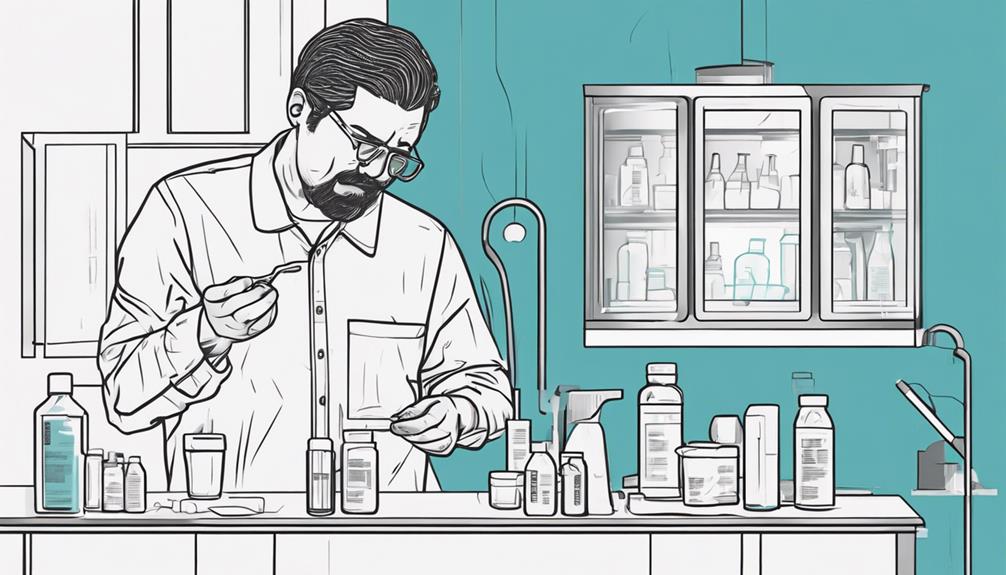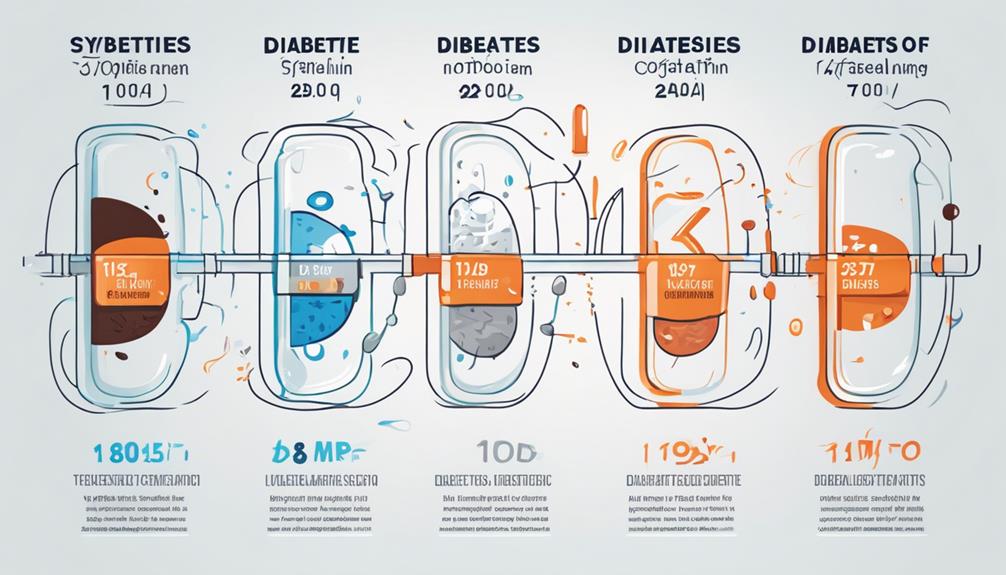Imagine waking up frequently during the night feeling extremely thirsty, despite drinking enough water during the day.
You might dismiss it as a temporary issue, but understanding the subtle signs of type 1 diabetes is crucial.
The journey to recognizing and interpreting these symptoms can be a pivotal step towards early diagnosis and proactive management.
By unraveling the complexities of how these symptoms manifest, you can empower yourself or others to take charge of their health in a timely manner.
Key Takeaways
- Recognize early signs like increased thirst and unexplained weight loss.
- Manage symptoms with regular blood sugar monitoring and insulin regimen.
- Seek prompt diagnosis for frequent urination and extreme fatigue.
- Support children by watching for symptoms such as sudden weight loss and irritability.
Common Symptoms of Type 1 Diabetes

Common symptoms of Type 1 diabetes typically include sudden weight loss, excessive thirst, and frequent urination. When managing these symptoms, it's crucial to monitor blood sugar levels regularly, adhere to a strict insulin regimen, and maintain a balanced diet to keep blood glucose levels stable. Engaging in regular physical activity can also help regulate blood sugar levels and aid in weight management.
The impact of these symptoms on daily life can be significant. Constantly feeling thirsty and needing to urinate frequently can disrupt your daily routine and affect your productivity. Sudden weight loss may lead to feelings of weakness and fatigue, making it challenging to engage in activities you once enjoyed. It's essential to develop coping mechanisms, such as seeking support from healthcare professionals and loved ones, to navigate these challenges effectively.
Early Signs to Watch For
As individuals affected by Type 1 diabetes navigate the challenges of managing common symptoms, it's crucial to remain vigilant for early signs that may indicate changes in their condition. Early warning signs such as increased thirst, frequent urination, unexplained weight loss, extreme fatigue, irritability, blurry vision, and slow-healing sores can be indicators of worsening diabetes control.
Monitoring blood sugar levels regularly and recognizing these signs promptly can help in adjusting treatment options and lifestyle changes to better manage the condition. Treatment options for Type 1 diabetes typically include insulin therapy, which may involve multiple daily injections or the use of an insulin pump.
Lifestyle changes such as adopting a balanced diet, engaging in regular physical activity, and maintaining a healthy weight are also crucial components of managing Type 1 diabetes effectively. By staying attentive to these early signs and promptly adjusting treatment and lifestyle, individuals can better control their diabetes and improve their overall health outcomes.
Symptom Progression and Severity

Monitoring the progression and severity of symptoms in Type 1 diabetes is crucial for effective management and treatment. As symptoms evolve, understanding their severity and how they progress can help tailor treatment plans and prevent long-term complications. Here are some key points to consider:
- Regular Monitoring: Keep track of your blood sugar levels and any changes in symptoms to adjust treatment accordingly.
- Consult Healthcare Providers: Seek guidance from healthcare professionals to optimize symptom management and treatment strategies.
- Lifestyle Adjustments: Implementing healthy lifestyle changes such as diet and exercise can positively impact symptom progression.
- Medication Adherence: Consistently following prescribed medication regimens is essential for symptom management and overall health.
- Preventing Complications: By effectively managing symptoms, you can reduce the risk of long-term complications associated with Type 1 diabetes.
Recognizing Symptoms in Children
To effectively manage Type 1 diabetes in children, it's crucial to keenly observe and recognize early symptoms that may indicate the onset of the condition. Pediatric warning signs for Type 1 diabetes in children include extreme thirst, frequent urination, sudden weight loss, fatigue, and irritability. These symptoms can develop rapidly over a few weeks.
Childhood diabetes indicators also encompass increased appetite, blurred vision, fruity-smelling breath, and yeast infections. It's vital to pay attention to these signs, especially if there's a family history of diabetes. If your child exhibits these symptoms, seek medical attention promptly for proper evaluation and diagnosis.
Additionally, unexplained bedwetting in a previously toilet-trained child could be a sign of diabetes. Being vigilant and recognizing these signs early can lead to timely intervention and better management of Type 1 diabetes in children, ensuring their long-term health and well-being.
Symptoms in Adults and Diagnosis

Have you noticed any unusual symptoms in yourself that could indicate Type 1 diabetes, and how is this condition diagnosed in adults?
When it comes to adults, the symptoms of Type 1 diabetes can sometimes be mistaken for other conditions, leading to potential misdiagnosis risks. It's crucial to pay attention to your body and seek medical attention if you experience any of the following:
- Excessive Thirst: Feeling constantly thirsty even after drinking fluids.
- Frequent Urination: Needing to urinate more often, especially waking up at night to do so.
- Unexplained Weight Loss: Losing weight without trying or making changes to your diet and exercise routine.
- Extreme Fatigue: Feeling unusually tired, even after getting enough rest.
- Blurry Vision: Experiencing sudden changes in vision clarity.
If you notice these symptoms, it's essential to consult a healthcare provider for proper diagnosis and symptom management to avoid any potential misdiagnosis risks associated with Type 1 diabetes.
Frequently Asked Questions
Can Type 1 Diabetes Symptoms Be Mistaken for Other Medical Conditions?
Yes, symptoms of type 1 diabetes can be mistaken for other medical conditions due to the overlap in signs like increased thirst, frequent urination, and unexplained weight loss, leading to misdiagnosis risks.
Are There Any Specific Triggers That Can Cause Type 1 Diabetes Symptoms to Worsen?
To help manage type 1 diabetes symptoms and prevent worsening, focus on dietary management and insulin therapy. Consistent monitoring of blood sugar levels, adjusting insulin doses as needed, and following a balanced diet can play a crucial role.
How Do Type 1 Diabetes Symptoms Differ Between Children and Adults?
When it comes to type 1 diabetes symptoms, kids and adults play by different rules. Children often show signs earlier, needing prompt intervention and specialized pediatric care. But remember, age is just a number!
Can Stress or Lifestyle Factors Play a Role in the Severity of Type 1 Diabetes Symptoms?
To manage the severity of type 1 diabetes symptoms, stress management and lifestyle modifications are crucial. Focus on mental health and coping strategies to navigate challenges effectively. Implementing healthy habits can positively impact symptom control and overall well-being.
Are There Any Long-Term Effects or Complications Associated With Untreated Type 1 Diabetes Symptoms?
Without treatment, Type 1 Diabetes can lead to severe long-term effects and complications. Untreated risks include kidney damage, nerve damage, heart disease, and vision problems. Managing the condition is crucial to prevent these consequences.
Conclusion
In conclusion, understanding the symptoms and diagnosis of type 1 diabetes is crucial for early detection and management of the condition. By recognizing common signs such as frequent urination, excessive thirst, and unexplained weight loss, individuals can seek medical attention promptly.
Whether it's in children or adults, being aware of the subtle changes in the body can lead to a timely diagnosis and effective treatment. Stay vigilant and proactive in monitoring your health to stay ahead of this chronic illness.